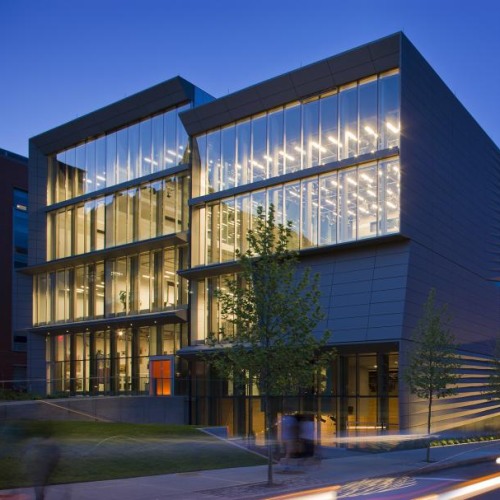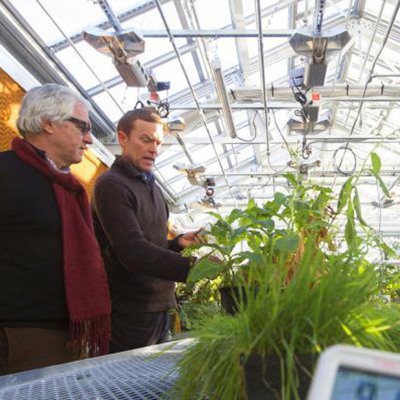This timeline chronicles more than 250 years of Brown University’s history.
These are key milestones from the 2010s.
This timeline chronicles more than 250 years of Brown University’s history.
These are key milestones from the 2010s.
With the oldest undergraduate engineering program in the Ivy League and third-oldest civilian engineering program in the country, in 2010, Brown transformed its Division of Engineering into the Brown School of Engineering. The new school continued Brown’s interdisciplinary approach to the subject, while, according to President Ruth Simmons, “maintaining and enhancing the engineering curriculum and research activities that attract the brightest students and the highest caliber faculty.”
July 1, 2010
In the Fall of 2010, Brown hosted Harvard in the first night football game at Brown Stadium. The Bears prevailed under the lights, 29–14.

September 25, 2010

Opening in 2011, the $40-million Perry and Marty Granoff Center for the Creative Arts featured a 218-person theater, recording and production studios, media labs, gallery space and an outdoor amphitheater. The interdisciplinary arts center fosters innovation, research, collaboration, creativity and education among the arts, humanities and sciences.
February 10, 2011
Researchers at the Brown Institute of Brain Science, part of the multi-institute BrainGate collaborative, discuss the trial of their investigative technology, in which a 58-year-old woman, paralyzed by a stroke for almost 15 years, uses her thoughts to control a robotic arm, grasp a bottle of coffee and serve herself a drink for the first time since her injury.
April 2011

After receiving a $100 million pledge from the Warren Alpert Foundation in 2007, the Brown Medical School took on a new name and began work on a new home. The Alpert Medical School opened its new 134,000-square-foot facility in August 2011 in Providence’s Jewelry District, ushering in a new period of growth in enrollment and programming.
August 15, 2011

At the time of her appointment in March 2012, Christina Paxson was Dean of the Woodrow Wilson School of International and Public Affairs and the Hughes Rogers Professor of Economics and Public Affairs at Princeton University. As Brown’s nineteenth president, Paxson has charted the course for the University’s future with the recently approved (October 2013) strategic plan, Building on Distinction: A New Plan for Brown. The Plan provides a vision and set of broad goals to achieve higher levels of distinction as a university that unites innovative education and outstanding research to benefit the community, the nation and the world. It calls for targeted investments to attract and support the most talented and diverse faculty, students and staff; capitalize on existing strengths; and provide the environment to foster rigorous inquiry and discovery across the disciplines. The Plan highlights the need to keep a Brown education affordable for talented students from all economic backgrounds and to sustain a community with the diversity of thought and experience required for excellence.
2012–Present
In July 2013, the new Brown School of Public Health officially opened. The transformation from the Public Health Program made the School of Public Health Brown’s third professional school, along with the Warren Alpert Medical School and the School of Engineering. At the opening, founding Dean Dr. Terrie "Fox" Wetle cited Brown’s strengths: “understanding, preventing and treating misuse of alcohol and other substances; in encouraging healthy behaviors by addressing physical activity, diet and tobacco use; and in improving health care delivery by studying service use, identifying the most appropriate evidence-based interventions and examining the impact of changes in health policy.”
July 1, 2013

With the bronze Bruno statue moved from the former Marvel Gymnasium to the College Green, the new athletic complex was without a mascot visible to passers-by. This was remedied by the installation of Indomitable, by British artist Nick Bibby, on the newly created Ittleson Quadrangle near the entrance to the Nelson Fitness Center. The imposing bronze statue towers over visitors to the Quad at 10 feet high (14 feet with its base).
November 2, 2013
The 10-year strategic plan, launched in 2014, offers the broad vision and goals to ensure the university’s capacity to fulfill its mission of teaching, research and service at the highest levels over the next decade.
2014
In 2014, a sculpture by American artist Martin Puryear was installed on the Front Green acknowledging Brown’s connection to the transatlantic slave trade. On commissioning the sculpture, President Simmons said, “Understanding our history and incorporating the full truth of that history into our shared heritage is challenging, but essential if we hope to live with wisdom and humanity.”
2014

In 2012–13, the former Hunter Laboratory was renovated to become the Building for Environmental Research and Teaching (BERT), a hub for cross-disciplinary teaching, research and engagement in the environmental sciences. Topping off the building is the Plant Environmental Center. The new greenhouse (replacing a ground-level facility that was used for nearly 50 years) has six rooms with computer-controlled temperature and lighting, supporting advanced botanical research.
January 2014
With its origins dating back three decades to Brown’s summer and continuing studies program, the School of Professional Studies was established as a standalone school in 2014 under the leadership of inaugural dean Karen Sibley. Through a range of distinctive degree and non-degree programs, the school expands the University's access and impact by reaching new communities of learners around the world and across the career continuum.
July 2014
Among the first of its kind in the nation upon its Fall 2016 launch, the center serves students who identify with any aspect of the first-generation or low-income experience, including international, undocumented, transfer and graduate students. Programs include outreach to incoming students, a peer mentoring program, financial aid, counseling and career advising, student and alumni networking, and community-building events.
2016
After an engagement process involving campus-wide discussion and input, President Paxson shared the Action Plan on February 1, 2016. It articulates Brown’s commitment to diversity, outlining a set of concrete, achievable actions to make the university a more fully diverse and inclusive community, and includes a timeline of significant milestones in Brown’s journey to become a more diverse and inclusive campus. Learn more about the plan.
2016
In February 2016, the Brown faculty voted to designate the second Monday in October as Indigenous People’s Day. The motion stated that renaming the day “would recognize the contributions of Indigenous People/Native Americans to our community and our culture and foster a more inclusive community.”
February 2016
The Royal Swedish Academy of Sciences awarded Professor J. Michael Kosterlitz the Nobel Prize in Physics in October 2016 “for theoretical discoveries of topological phase transitions and topological phases of matter.” Kosterlitz became the second Nobel laureate on the Brown physics faculty, joining Leon Cooper, who won the prize in 1972.
October 2016
After years of private-public partnership to transform the long-vacant former South Street Power Station into a mixed-used space, Brown’s relocation of 400 staff members in October 2017 brought new vibrancy to Providence's Jewelry District neighborhood.
October 2017
With the opening of the 2018-19 academic year, the University launched its initiative that replaced University-packaged loans with scholarship funds in financial aid packages for all returning and incoming undergraduate students. The move came less than three months after Brown launched an ambitious campaign to raise initial funds for the initiative.
2018